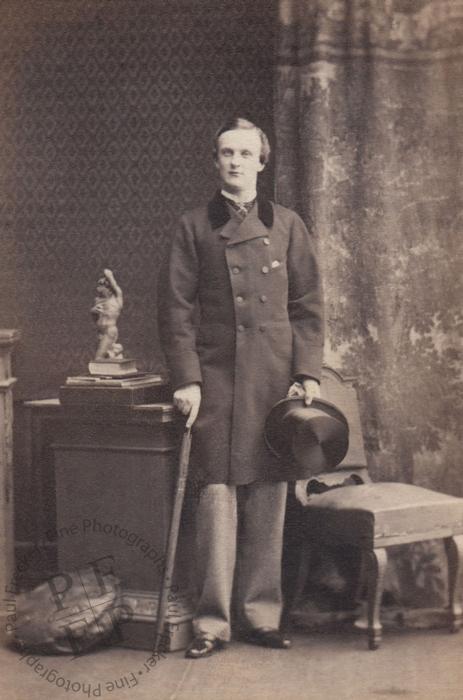George Murray Farquharson
(1835-1899)
27 March 1861
Volume 3, page 6, sitting number 2733.
Born on 16 August 1835 at Braemar in Scotland, George Murray Farquharson was the third son of James Farquharson of Invercauld, Aberdeenshire. His mother was Jane Hamilton née Dundas.
He appears on the 1861 census, living at 15 Park Lane in Mayfair with his eight siblings, his parents and their seventeen live-in servants, including a butler, two footmen and a coachman. For his profession, he gave ‘Clerk [in the] War Office.’
On 3 January 1882 he married Ethel Maud, second daughter of Rupert Pennefather Featherstonhaugh. For his profession on his marriage certificate he wrote simply ‘In the War Department.’
He ‘was at one time senior clerk in the War Office, and was secretary and registrar of the Distinguished Service Order’ (Aberdeen Press and Journal, 9 May 1899).
George Murray Farquharson died, aged 63, on 7 May 1899 at 39 Egerton Gardens, Kensington, leaving an estate valued at £5841. He was buried in the family mausoleum at Braemar.
The following Sunday the minister at Braemar closed his sermon with a heartfelt eulogy to his former parishoner. ‘I cannot close these remarks to-day without making reference to the late Mr George Murray Farquharson, over whose mortal remains the grave closed on Friday within the last resting place of his fathers, in our old churchyard. […] Going out and going in in our midst as he did, with all the simple and natural unaffectedness and kindliness which were so characteristic of him, his visits at every homestead were gladly welcomed; and when he recalled, as he often delighted to do, with the older retainers of his house the scenes and associations of his early youth and manhood – well remembered adventures of flood and field – he charmed his old companions by his vivid and minute recollections of them. […] The magnificent surroundings of his early home indeed seemed to have a perennial charm for him – every hilltop, crag, peak, precipice, and moorland was familiar to him. It was delightful to meet one who seemed so untainted by the busy world’s customs and habits, and who retained a spirit so unconventional, so fresh and receptive to nature’s beauties as his seemed to be. […] A man of deep religious connections, of high Christian character, one who carried his religious principles into his daily life, such assuredly was the impression conveyed to me by all I have seen and known of him, and I doubt not that such has been the estimate of others who knew him better and longer than I was privileged to do. A more devout, reverent, or regular worshipper in the House of God I have not known. I believe he liked our simple Presbyterian worship – certainly he never failed to avail himself of it. Of Mr George Farquharson’s official life and the difficult duties which must often have been his in so important a State Department as that of the War Office, we here can, of course, know nothing; but of this we may feel sure, that these duties were performed by him not only with much ability, grasp of principle, and mastery of detail, but one could hardly conceive of him doing anything except in the most thorough and painstaking way’ (Aberdeen Press and Journal, 16 May 1899).
[A portrait of his sister, Henrietta Farquharson, appears on page 16 of this section; a portrait of his brother, John Atholl Farquharson, can be found on page 34 of the same section.]

